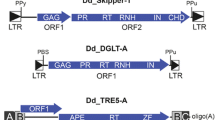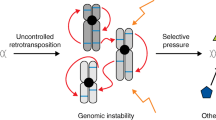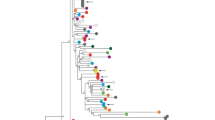Abstract
Transposable elements represent a large fraction of eukaryotic genomes and they are thought to play an important role in chromatin structure. ZAMand Idefixare two LTR-retrotransposons from Drosophila melanogastervery similar in structure to vertebrate retroviruses. In all the strains where their distribution has been studied, ZAMappears to be present exclusively in the intercalary heterochromatin while Idefixcopies are mainly found in the centromeric heterochromatin with very few copies in euchromatin. Their distribution varies in a specific strain called RevI in which the mobilization of ZAMand Idefixis highly induced. In this strain, 15 copies of ZAMand 30 copies of Idefixare found on the chromosomal arms in addition to their usual distribution. Amongst the loci where new copies are detected, a hotspot for their insertion has been detected at the whitelocus where up to four elements occurred within a 3-kb fragment at the 5′ end of this gene. This property of ZAMand Idefixto accumulate at a defined site provides an interesting paradigm to bring insight into the effect exerted by multiple insertions of transposable elements at an euchromatic locus.
Similar content being viewed by others
References
Baldrich, E., P. Dimitri, S. Desset, P. Leblanc, D. Codipietro & C. Vaury, 1997. Genomic distribution of the retrovirus-like element ZAM in Drosophila. Genetica 100: 131–140.
Britten, R.J., 1996. Cases of ancient mobile element DNA insertions that now affect gene regulation. Mol. Phylogenet. Evol. 5: 13–17.
Carmena, M. & C. Gonzalez, 1995. Transposable elements map in a conserved pattern of distribution extending from betaheterochromatin to centromeres in Drosophila melanogaster. Chromosoma 103: 676–684.
Carteau, S., C. Hoffmann & F. Bushman, 1998. Chromosome structure and human immunodeficiency virus type 1 cDNA integration: centromeric alphoid repeats are a disfavored target. J. Virol. 72: 4005–4014.
Dej, K.J., T. Gerasimova, V.G. Corces & J.D. Boeke, 1998. A hotspot for the Drosophilagypsy retroelement in the ovo locus. Nucleic Acids Res. 26: 4019–4025.
Desset, S., C. Conte, P. Dimitri, V. Calco, B. Dastugue & C. Vaury, 1999. Mobilization of two retroelements, ZAMand Idefix, in a novel unstable line of Drosophila melanogaster. Mol. Biol. Evol. 16: 54–66.
Dimitri, P., B. Arca, L. Berghella & E. Mei, 1997. High genetic instability of heterochromatin after transposition of the LINElike I factor in Drosophila melanogaster. Proc. Natl. Acad. Sci. U.S.A. 22; 94(15): 8052–8057.
Dorer, D.R. & S. Henikoff, 1994. Expansions of transgene repeats cause heterochromatin formation and gene silencing in Drosophila. Cell 77: 993–1002.
Dorn, R., V. Krauss, G. Reuter & H. Saumweber, 1993. The enhancer of position-effect variegation of Drosophila, E(var)3-93D, codes for a chromatin protein containing a conserved domain common to several transcriptional regulators. Proc. Natl. Acad. Sci. USA 90: 11376–11380.
Gerasimova, T.I., D.A. Gdula, D.V. Gerasimov, O. Simonova & V.G. Corces, 1995. A Drosophilaprotein that imparts directionality on a chromatin insulator is an enhancer of position-effect variegation. Cell 82: 587–597.
Geyer, P.K. & V.G. Corces, 1992. DNA position-specific repression of transcription by a Drosophilazinc finger protein. Genes Dev. 6: 1865–1873.
Hirschhorn, J.N., S.A. Brown, C.D. Clark & F. Winston, 1992. Evidence that SNF2/SWI2 and SNF5 activate transcription in yeast by altering chromatin structure. Genes Dev. 6: 2288–2298.
Ji, H., D.P. Moore, M.A. Blomberg, L.T. Braiterman, D.F. Voytas, G. Natsoulis & J.D. Boeke, 1993. Hotspots for unselected Ty1 transposition events on yeast chromosome III are near tRNA genes and LTR sequences. Cell 73: 1007–1018.
Kalpana, G.V., S. Marmon, W. Wang, G.R. Crabtree & S.P. Goff, 1994. Binding and stimulation of HIV-1 integrase by a human homolog of yeast transcription factor SNF5 (see comments). Science 266: 2002–2006.
Lajoinie, O., M.E. Drake, B. Dastugue & C. Vaury, 1995. Aberrant pre-mRNA maturation is caused by LINE insertions into introns of the white gene of Drosophila melanogaster. Nucleic Acids Res. 23: 4015–4022.
Leblanc, P., B. Dastugue & C. Vaury, 1999. The integration machinery of ZAM, a retroelement from Drosophila melanogaster, acts as a sequence-specific endonuclease. J. Virol. 73: 7061–7064.
Leblanc, P., S. Desset, B. Dastugue & C. Vaury, 1997. Invertebrate retroviruses: ZAM a new candidate in D. melanogaster. Embo J. 16: 7521–7531.
Lohe, A.R., A.J. Hilliker & P.A. Roberts, 1993. Mapping simple repeated DNA sequences in heterochromatin of Drosophila melanogaster. Genetics 134: 1149–1174.
Pimpinelli, S., M. Berloco, L. Fanti, P. Dimitri, S. Bonaccorsi, E. Marchetti, R. Caizzi, C. Caggese & M. Gatti, 1995. Transposable elements are stable structural components of Drosophila melanogasterheterochromatin. Proc. Natl. Acad. Sci. USA 92: 3804–3808.
Robertson, H.M., C.R. Preston, R.W. Phillis, D.M. Johnson-Schlitz, W.K. Benz & W.R. Engels, 1988. A stable genomic source of P element transposase in Drosophila melanogaster. Genetics 118: 461–470.
Sandmeyer, S.B., L.J. Hansen & D.L. Chalker, 1990. Integration specificity of retrotransposons and retroviruses. Annu. Rev. Genet. 24: 491–518.
Zhang, P. & A.C. Spradling, 1995. The Drosophilasalivary gland chromocenter contains highly polytenized subdomains of mitotic heterochromatin. Genetics 139: 659–670.
Zhu, Y., S. Zou, D.A. Wright & D.F. Voytas, 1999. Tagging chromatin with retrotransposons: target specificity of the Saccharomyces Ty5 retrotransposon changes with the chromosomal localization of Sir3p and Sir4p. Genes Dev. 13: 2738–2749.
Zou, S. & D.F. Voytas, 1997. Silent chromatin determines target preference of the Saccharomyces retrotransposon Ty5. Proc. Natl. Acad. Sci. USA 94: 7412–7416.
Author information
Authors and Affiliations
Rights and permissions
About this article
Cite this article
Conte, C., Calco, V., Desset, S. et al. Impact of Multiple Insertions of two Retroelements, ZAM and Idefix at an Euchromatic Locus. Genetica 109, 53–59 (2000). https://doi.org/10.1023/A:1026534207401
Issue Date:
DOI: https://doi.org/10.1023/A:1026534207401




